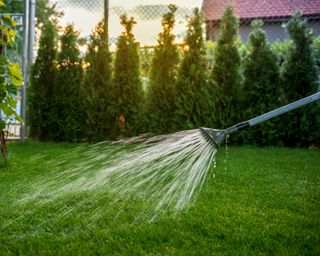

Everyone knows lawns need a good amount of water to keep them green and thriving but what's the right amount? You may actually be watering your lawn too often or not enough.
We asked professional gardeners and landscapers for their advice to make this outdoor task a little more clear. We got the low-down on how often you should be watering your lawn, how much water you should be using, and the best time of day to give it a good soak.
See their helpful lawn care tips to keep your front and backyards properly hydrated.
How long should you water a lawn for?
If you're new to landscaping, it may be a little stressful to learn all the ins and outs of lawn maintenance. Once you've mowed your lawn to get it looking neat and tidy, you'll have to give it some water to keep it hydrated and growing strong.
But how much water does it actually need? It's an important piece of info to avoid a waterlogged yard. Thankfully, the pros are here to help.
"It's recommended to water your lawn for 30-45 minutes every second day, ideally between 4 AM and 7 AM," says Melissa Erin, Chief Strategy Officer of Paramount Landscaping Inc.
"This early morning timing helps prevent water loss due to evaporation and reduces the risk of disease, as the grass has time to dry during the day. Watering during this period also ensures the water soaks deeply into the soil, reaching the roots more effectively," says Melissa.

Finding the right time for you
When it comes to landscaping, a certain amount of customization is necessary. After all, one person's yard may be vastly different from another's. The time of year may also affect your watering schedule as summer lawn care has different requirements due to the heat.
"The amount of water your lawn needs can vary based on factors like climate, soil type, and the specific grass species. A general rule of thumb is to aim for about 1 inch of water per week, including rainfall, to keep your lawn healthy. One practical way to measure this is by using a rain gauge or even a simple can to collect and measure water depth," says Melissa.
The good news is, when it comes to frequency, sometimes less is more. "Different-sized lawns will obviously need different amounts of water to cover. We recommend using a hose to water deeply and infrequently, rather than shallow and frequently so that the ground below the lawn becomes fully soaked. The more water that gets through to the ground below the better as it encourages the root systems to grow downwards into the soil towards the moisture and helps improve the stability of the turf," says Chrissie Handley, a lawn care specialist working for Online Turf.

How to know if your lawn needs water
It can be a little tricky to know when your lawn is in need of water, especially if you have an unconventional yard like a clover lawn. "To check if your lawn has been adequately watered, you can use the 'finger test.' Simply insert your finger into the soil up to the first knuckle (about an inch deep). If the soil feels moist, you've provided enough water. If it's dry, you may need to water a bit more," says Melissa.
You can generally tell if your lawn is in need of water by feeling and looking at the grass. "A well-watered lawn will have a uniform green color and will spring back when walked on. If the grass blades remain flattened after being stepped on, it might be a sign of insufficient water. Regularly checking the soil moisture and observing your lawn's response can help you fine-tune your watering schedule," Melissa explains.
Lawn care essentials

Price: $9.99
Your hydrangeas are going to need regular watering, so it's worth it to invest in a handy watering can. With over 8,000 ratings, this budget-friendly watering can is loved by customers. It comes with a detachable nozzle so you can choose a direct stream or a gentle shower. It's available in seven colors including pastel pink and neon yellow. Shoppers compliment how easy it is to use and the large capacity to hold water.

Price: $9.44
You're going to need a good garden hose to water your lawn. This 25-foot hose is constructed with a three-ply material complete with ergonomic, soft-grip handle, and radial reinforcement. It also comes with a three-year warranty so it's guaranteed to last.

Price: $28.67
Looking to fix some patches in your yard? This bestselling grass seed is combined with fertilizer and soil improver for an all-in-one solution. Each seed is wrapped in a unique WaterSmart Coating to absorb two times more water and keep seeds moist twice as long as uncoated seeds. One reviewer says, "This product has exceeded my expectations in every way. It’s transformed my lawn from dull to dazzling in no time at all."
In addition to watering, make sure to maintain your yard by aerating the lawn. Finding the right type of grass to use is also an important step. "Incorporating native or drought-resistant grasses and plants into your lawn can reduce water needs, as these species are adapted to local climate conditions and require less maintenance," says Melissa.
Join our newsletter
Get the best home decor ideas, DIY advice and project inspiration straight to your inbox!

Hey! I’m Emily and I’m the deputy digital editor at Real Homes. I’m here to bring you the latest decor trends, inspirational ideas, informative how tos, the latest celeb homes style and the best budget-friendly buys. I live in a rented apartment, making the most of small spaces and using accent pieces to make things pop. When I’m not writing, I’m usually doing yoga, eating chocolate or working on my skincare routine.